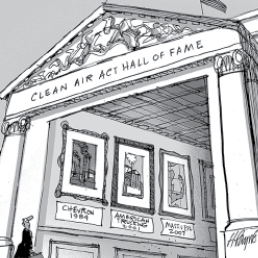Navigating through the tail end of Hurricane Oscar in the North Atlantic two years ago, the international crew of our cutter fought off seasickness as we battled to stay on course toward the finish line off Madeira. “If we make it to Faro,” we shouted to each other during lulls in the gale, “we will be fine.” When my turn came at the helm, I held to a compass heading that would bring us down to latitude 37 and calmer water off the Portuguese port city, where we could lay in a course for the finish line. Instead of pressing on dangerously under a full suit of canvas, risking sails and spars for greater speed, we kept the main reefed and thus were able to safely make good headway in the rough seas. It was a good decision.
I have found through a lifetime of experience that sailing is an excellent metaphor for the adventures in reaching my longtime professional goal of “justice for all,” the central promise of the Pledge of Allegiance but a destination still beyond the horizon after all these years of environmental law. Everybody uses metaphors to organize their thinking, often drawing from sports like football and baseball. Making it to Faro by harnessing the wind no matter how it blows has become the destination in my professional life. Only from there can you actually set a course toward your goal.
The analogy between the environmental profession and the job of the mariner is a useful one. Ever resilient, sailors are constantly adjusting the rigging to get the most from the wind while avoiding unnecessary risk to the crew and ship. Staying on an even keel is important. They are careful to preserve and allocate food and water resources sustainably and manage waste responsibly. Safety is constantly in force underway. Both skipper and crew know their destination at all times. And they know how to make port even under contrary winds.
Indeed, I learned at the outset of my career in the 1980s that sailing the waters of environmental law and justice can be rough. As founder and president of the Legal Environmental Assistance Foundation, based in Tallahassee, I took to court EPA and other government agencies and multinational corporations as well. LEAF worked with communities burdened by pollution, disease, poverty, and crime. I learned from those most impacted by harmful emissions and discharges, as we made significant yet insufficient progress on our great circle course to environmental equity and justice.
Then, in 2009, when newly elected President Obama declared he wanted change, I joined EPA’s Office of Environmental Justice to become senior counsel. My professional mantra upon leaving public interest practice to join government — my sea chanty so to speak — started with, “For 20 years, I sued EPA,” and concluded on an up note, “Now I am going to work for them.” The lighthouse beacon guiding my government service became the personal voices of those who literally live and die as a result of agency decisions and actions. Their flashing signal patterns illuminated government systems and their actions that foster healthy, equitable, and sustainable communities and those that either intentionally or unintentionally perpetuate environmental injustices. The people we worked with who were affected by pollution were the first to know there was a problem and what was needed to solve that problem.
Yes, my metaphor helped me to see that and gave the point of sail to best capture the wind. That heavy weather sailing along the coast of Spain and Portugal to the northern coast of Africa, along with bareboating around equatorial islands, has taught me that in fact sailing has many lessons for professionals. My lifelong mission has been to work with those who in effect are finding environmental, health, and economic storms crashing over their decks with insufficient means of altering the set of the sails to make headway. Gaining a navigator’s skills in the law and in the science of epidemiology, including degrees in both, has enabled me to act as a pilot, helping citizens steer their communities toward greater equity and justice.
Now, as the challenges facing overburdened, underserved, and underrepresented communities escalate in horrific, relentless waves of heartbreak, especially as seen in the context of Black Lives Matter and the simultaneous COVID-19 crisis, I am again changing vessels, joining the research, service, and teaching crew at the Yale School of Medicine, Child Study Center and Elevate Policy Lab.
At this new waypoint in life, I am pulling together my collective experiences to reset my compass heading, prepare my passage plan, aiming always for the same destination: justice for all. All I know at the outset of this voyage is that it will require leveraging the lessons of the sea and of the men and women who venture out regardless of the weather conditions or a gloomy forecast, for resilience and sustainability are their working tools too.
The first lesson in sailing is to appraise the state of the sea — the wind, the waves, the swell, and weather patterns — when embarking on a voyage and during the passage. This lesson clearly applies to the trajectory of my career in environmental justice, a timeline of constant appraisals and course changes.
If there were a logbook on environmental protection and regulation of pollution since the 1980s, it would be revealing in its constant changes. The log would be a story of denial — a hesitancy to consider the real state of the sea and a rejection of that primary lesson. The first entries show the existence of pollution being denied. When pollution became acknowledged, exposure to people was denied. When pollution and exposure were acknowledged, impact to human health was denied. When pollution, exposure, and impact were acknowledged, the consequences to vulnerable populations — including communities of color, poor neighborhoods, and tribal-indigenous groups — were denied.
This phenomena of ignoring sea states and weather patterns is illustrated through a LEAF lawsuit whose resolution spanned four decades. In 1983, the Department of Energy admitted that it had released two million pounds of mercury from the Y-12 Plant at Oak Ridge between 1950 and 1977. The pollution flowed into the Tennessee River. Unknowingly, low-income rural families swam and fished in the river and a polluted tributary, East Fork Poplar Creek. In the period of denying pollution, elemental mercury was carried from the Y-12 plant by workers into their homes, exposing their families to harmful vapors. While government denied exposure, children who swallowed water during play in the brook were exposed to levels of inorganic mercury that could cause kidney damage, and residents ate fish from the polluted brook, risking the health of their brains.
When pollution, exposure, and impact could no longer be denied, children born to or nursing from women who ate certain species of fish from Poplar Creek were revealed as at increased risk of subtle neurodevelopmental health effects. When LEAF sued 37 years ago, arguing that DOE must comply with the Resource Conservation and Recovery Act, the department argued in court that application of RCRA to Y-12 was inconsistent with the Atomic Energy Act of 1954, which restricted dissemination of classified information pertaining to nuclear weapons and material. Action under RCRA, the department argued, would subject this information to public disclosure. In LEAF v. Hodel, the court held that the plant indeed is subject to RCRA, ruling that DOE had failed to demonstrate that compliance with the landmark statute would result in the disclosure of classified material.
Surprisingly, as an early porthole view into the operation of the federal government that would carry me through my time with EPA, most of the DOE managers and staff supported the decision and embraced the programmatic result: establishment of DOE’s Hazardous Waste Remedial Action Program to address dangerous materials at all of its facilities. This attitude toward the decision is also reflected in the department’s published “Nuclear Energy Timeline”: for the decade of the 1980s, DOE highlighted LEAF v. Hodel along with the “Berlin Wall is torn down. Many communist governments in Eastern Europe collapse.” To have LEAF recognized in the same space with the fall of communism instilled the same pride as does finding the island in the middle of the ocean.
Yet, as ocean currents flow year after year at the same speed and direction, so has been the DOE environmental challenge. Indeed, when joining EPA 26 years after we sued, the first environmental impact statement I reviewed was for the disposal of the hazardous waste from the Y-12 plant.
Invoking environmental justice, I raised the issue that one of the primary site locations was a few miles from a town in Texas that was predominantly Latino, and where the English proficiency was lower than 40 percent. Because Texas is a majority-minority state, the site was not considered to be an environmental justice community. We nonetheless proposed mitigation measures to address these disproportionate impacts, including translating critical documents into Spanish. The lessons learned from this decades-long legal action informed the development of an environmental justice analytical methodology for National Environmental Policy Act reviews.
Favorable sailing conditions were in play due to the leadership of the federal Interagency Working Group on Environmental Justice, or IWGEJ. In 2011, its 17 federal departments and agencies signed the “Memorandum of Understanding on Environmental Justice” and were included under Executive Order 12898, promulgated by President Clinton to establish environmental justice as a goal of the federal government.
The EO identifies NEPA as one of four areas of focus. As founding co-chair (along with the Department of Transportation and then DOE) of the NEPA Committee created in 2012, I worked with NEPA and EJ practitioners across the federal family. Our membership grew from 12 to 200 members, and we produced “Promising Practices for Environmental Justice Methodologies in NEPA Reviews.” This sea chart, along with the “Community Guide for Environmental Justice” and “NEPA Methods (2018),” advance consistent, effective, and efficient consideration of environmental justice under the foundational statute. Through the NEPA Committee, we now had a fleet of vessels recommitted to addressing environmental justice through a more collaborative, comprehensive, and efficient process.
Just as there are always more storms, rulemaking on NEPA now threatens to overwhelm progress. But, a boat sailing in a massive storm cannot stop, and we must call all hands-on-deck to get to a safe destination for all — to get to Faro.
Sailing lesson number two counsels that when underway in a storm, remember that the sea takes no prisoners. When sailing, failure to prepare and to account for real people, real places, and real conditions can kill you. Tragically, failure to account for unique conditions experienced by low-income, people of color, and tribal-indigenous populations is deadly. Pollution, natural and man-made disasters, unhealthy built environments, and lack of access to essential services are killing these populations at disproportionate rates.
At the outset of my career, I challenged the demand for a “dead body count approach” to justify environmental regulation of pollution. Acknowledging only mortality while ignoring morbidity and disability sets the stage for environmental devastation. Decades later, with COVID-19 on the loose, my greatest fear has come to fruition — we have the dead bodies as evidence of disproportionate impact and failure to protect health and the environment of overburdened, underserved, and underrepresented populations. COVID-19 cases by race and ethnicity show the incidence of the virus out of proportion to the percentage of the overall U.S. population — it is almost double for Hispanic, black, and American Indian/Alaskan Native populations.
A closer look by Centers for Disease Control and Prevention researchers shows that people with underlying health conditions were six times more likely to be hospitalized than those with no such conditions, and deaths were 12 times higher. Communities disproportionately burdened by pollution have long experienced higher rates of chronic disease. Now we see higher rates of COVID-19 hospitalizations and higher deaths as a result.
Many of the pre-existing conditions that increase the risk of death in those with the virus are the same diseases that are affected by long-term exposure to air pollution. A small increase in long-term exposure to the fine particles produced by burning fossil fuels, known as PM2.5, leads to a large increase in the coronavirus death rate. Thus, the virus, through the same vicious cycle of denial and the dead-body-count approach experienced with environmental degradation, is thrust on the same overburdened, underserved, and underrepresented population. Now, my integrated law and public health degrees allow me to heave to under a storm sail and help rescue the multitudes drowning in this deathly sea. More rescue boats in the water would be a huge help. There are thousands of communities needing assistance.
The faces of this nightmare are made real in Lowndes County, Alabama, in the so-called Black Belt, where I have worked on environmental justice across the decades. Reading the horrific news that the rates of COVID-19 are higher in this rural, poor, African American population than in New York City, I recalled our long-ago community victory in stopping the permitting of a fly-by-night hazardous waste disposal facility when I was at LEAF. I see the face of the elderly African American farmer who was more knowledgeable about the conditions of the soil and groundwater than the Ph.D. experts representing the hazardous waste company. I remember this early lesson that the people impacted by pollution should be at the table from the beginning and throughout the decisionmaking process — they should be at the forefront in diagnosing the problems and designing the solutions, and should be part of the cross-training of all stakeholders.
While at EPA, I met families in Lowndes County who step outside their trailers into their own excrement because they lack effective decentralized sewer capacity. I hear the voice of government officials dismissing these health and environmental concerns, callously claiming that “these people would rather get sick twice a year and spend their money on cell phones then pay for the maintenance of a septic tank.”
But, from heartbreak to hope, we reef our sails to avoid the winds of injustice while rapidly propelling progress through the choppy waves. Recognizing that environmental challenges in rural communities were distinct from those faced by urban communities, the EJIWG established the Rural Communities Committee in 2015. With Lowndes County in mind, the working group advanced brownfields-to-healthfields and urban-to-rural agriculture as destinations for communities across Appalachia, Southern California, coastal Georgia, and the Black Belt.
The EJIWG recruited a crew of environmental justice bosuns across the federal family to join the impacted communities and a courageous state public health captain. Together, we navigated the waves of environmental, technical, financial, health, and governance challenges to overcome the underlying currents that had become excuses. As 100 families were on the verge of getting safe sewer systems, we began to celebrate. And then, the county that wanted a health clinic and truck stop but got only the truck stop started dying faster and faster from COVID-19. The huge swell of institutional racism buttressing the denial and the dead-body-count approach to environmental protection crashes over our deck. It is time for a better course to get us to Faro.
The third lesson all sailors must learn is that on ocean passages, carefully choose your vessel and know your coordinates and compass heading to get all passengers and crew safely to port. When I first opened LEAF in the early 1980s, there was no such thing as environmental public health protection. Regulation of pollution was a concept reserved for tree huggers. Ultimately, during my LEAF days and continuing throughout my career at EPA, my EJ colleagues taught me that environmental protection means “people impacted by pollution should live, learn, work, play, and pray in homes and communities where the air is safe to breath, water safe to drink, and land safe to touch.” Ultimately, they want their children and families to be healthy, their homes and neighborhoods to be safe from pollution and crime, and yet they also want to keep their jobs.
Fortunately, during my passage with EPA, I have crewed on voyages seeing significant progress along the rhumb line toward environmental justice that responds to the well-being of vulnerable children, adults, families, and communities. It has been inspirational to work with career and political leaders under multiple administrations to bust the myth that protection of the population in general is sufficient. A rising tide lifts all boats only works if everybody has a boat.
The notion that environmental protection only addresses natural resources such as air, water, and land has been debunked. Environmental assessments and related decisions that do not consider vulnerable subpopulations are no longer sufficient. That consideration includes multiple exposures and body burdens of those facing pollution, poverty, disease, and crime.
Because environmental statutes mandate protection of human health and the population as a whole, EJ professionals have expanded our focus to consider the built environment and access to essential services. We also have come to recognize that access to health care (physical, mental, social, spiritual), food security, transportation options, and physical activity are essential components of environmental protection. Natural disasters are escalating, wreaking disproportionate havoc on vulnerable and overburdened populations. Disaster response, recovery, and preparedness have thus become an environmental justice issue as well.
The trip to the far off but welcoming port of justice for all is far from over. Disastrously, now our progress is being rolled back with a return to denial and the dead-body-count approach for the most vulnerable of society. In such chaotic seas I have made a safe port on Long Island Sound and am embarking on a new ship to the same destination. It will be a challenging voyage under changing conditions.
The fleet comprising Yale Med’s Child Study Center and Elevate Policy Lab includes a stellar ship and crew making a direct impact for real people and real places through innovation and rigorous, evidenced-based approaches. That’s my newest vessel. Our compass heading aims for healthy children, mothers, and families living in communities safe from pollution and violence, as a pathway to economic and social mobility. Our passage plan is to disrupt the current against progress of intergenerational poverty, disease, and environmental degradation.
Getting to this destination comports with my life’s course thus far, given that psychosocial stressors are recognized as a fundamental environmental justice disproportionate-impact factor. Yale’s Elevate Policy Lab, which operates the Mental Health Outreach for Mothers Partnership, provides mental health care to disadvantaged mothers as heads of households and fosters collaboration with community organizations, health care providers, and government partners for systemic change.
Mariners are charged with ensuring that each sail on the vessel is drawing maximally at the same time, knowing that the set of each affects the other. At this point in my career, my course now requires achieving the best trim for each of three goals at the same time. We are simultaneously aiming at health, economic, and environmental challenges facing disadvantaged populations. In my triple-bottom-line justice approach, we are working with women experiencing toxic stress from food insecurity, transportation limitations, and domestic violence, helping to increase their capacity to improve their maternal mental health and help them meaningfully engage in government decisions that affect their lives.
We seek to dislodge the anchors that are the root causes of disparities, strengthen meaningful engagement of impacted populations, and improve measurable, cost-effective outcomes. We rely on the community-based experience that fills my entire career now, trusting that meaningful engagement of underserved, overburdened, and underrepresented individuals via all levels of government improves the health also of their communities as measured by the triple bottom line.
As we knew sailing from the northwest tip of Spain to an island off the coast of Africa, and as I know now after a lifetime’s experience, a boat making way in a massive storm cannot stop. In our metaphorical quest to extract from the law of the sea lessons to achieve environmental justice for all people, and for all communities, we must ensure that we first get to the calmer waters off Faro. Only when we get there can we shake out a reef and put the helm over for a course to the finish line. TEF






